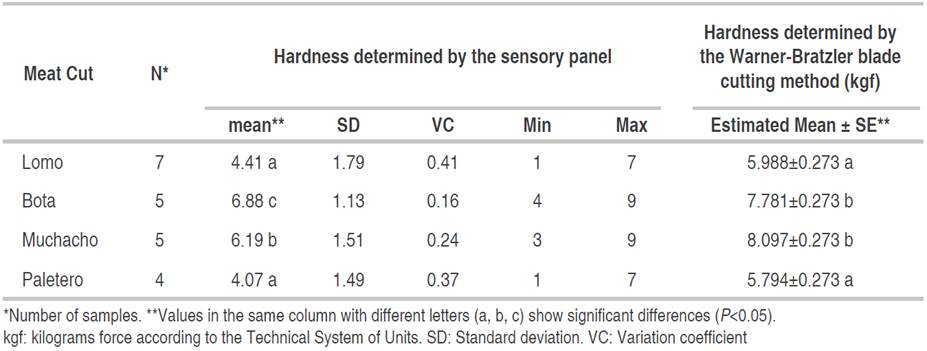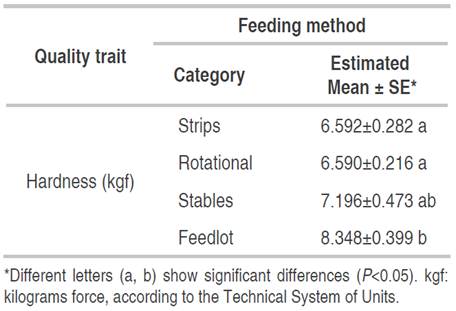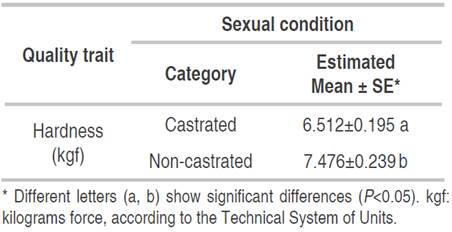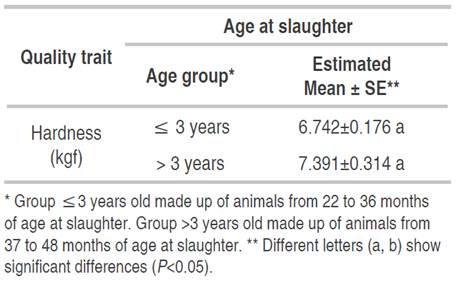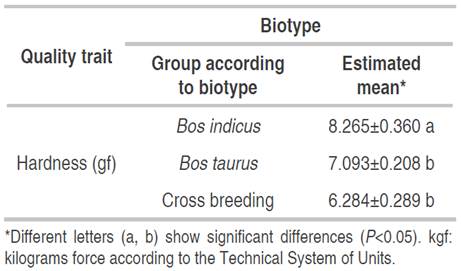Meat and derived products are an important source of protein in human diets and their consumption depends on physiological factors (determined by individual characteristics), sensory (specific to the product), and the consumer environment. Among the sensory factors, tenderness and juiciness are quality attributes that positively influence consumer preferences and ensure acceptance, purchase, and loyalty to the product (Font-i-Furnols and Guerrero, 2014; Desgarennes et al., 2017).
Tenderness is defined as the difficulty or easiness of cutting or chewing a piece of meat, being the result of factors intrinsic to the animal, the production system, and the post-mortem process. The first factors include sexual condition, age at slaughter, genetics, individual performance and nutrition, variables that can be managed and optimized within the production systems and affect the product obtained and its value in the market (Quiroga, 2005; Vásquez et al., 2007; Braña et al., 2011; Torrico et al., 2018).
Physicochemical properties including proximate composition, pH, color, water-holding capacity, tenderness, and sensory properties are different between meat cuts. Many studies have been conducted on meat quality traits of various meat cuts among the carcasses of different species (Cheng et al., 2020).
Tenderness has been quantified through instrumental methods; the Warner-Bratzler blade cutting force (Warner Bratzler shear force) is one of the most widely used tests due to its robustness and correlation with sensory measurement; likewise, the qualitative determination through a sensory panel is commonly used to determine the degree of tenderness or hardness of meat cut and their acceptance by consumers. In this way, international scales have been established that make it possible to correlate the values obtained by instrumental methods with sensory perception and thus classify various types of beef cuts (Destefanis et al., 2008; Braña et al., 2011; Cuetia, 2012).
This study aimed to determine the influence of biotype, age at slaughter, sexual condition, and nutrition in dual-purpose animals in the high tropics on the hardness of four commercial meat cuts, through the instrumental measurement (Warner-Bratzler shear force test) and their relationship with to a sensory panel in order to create a scale to measure hardness locally.
MATERIALS AND METHODS
Experimental animal selection
In this study, 50 male bovines castrated (n=22) and non-castrated (n=28) with slaughter weights between 460 and 530 kg were selected from dual-purpose productive systems located in the highland tropics (above 1800 to 3500 masl) in Cundinamarca, Colombia. The animals studied were classified according to their biotype, considering the phenotype and the predominant characteristics in each one. The taurus biotype was composed of animals with characteristics of the Normande breed in the majority and small groups of Angus, Charolais, Simmental, Limousin and crosses with Normande. For the indicus biotype specimens of the Brahman breed were evaluated and for the cross biotype, animals of the Brahman x Normande, Charolais x Brahman, Simbrah and Brangus crosses were found.
The ages at slaughter were classified into 2 ranges: from 22 months to 36 months for the group aged ≤ 3 years and animals from 37-38 months to 48 months of age at slaughter for the group >3 years. Age was determined according to farm records on the slaughter day or at the slaughterhouse through dental chronometry.
The diet of the animals was classified into 4 categories: stable, which was based on feeding Pennisetum purpureum or Axonopus scoparius grass, palm kernel cake, wheat, potato by-products and corn silage supplemented with the contribution of concentrate; rotational, which was described as grazing with a period of permanence in the pasture of 5 to 7 days and a rest period of the meadow that varied from 45 to 120 days depending on the type of grass (Pennisetum clandestinum, Lolium perenne, Holcus lanatus, Paspalum dilatatum and their associations), red clover (Trifolium pratense) and white clover (Trifolium repens); the third category was grazing in daily strips with rest days for the meadow that varied from 40 to 90 days depending on the used species (Pennisetum clandestinum, Holcus lanatus and their combinations), with red clover (Trifolium pratense) and white clover (Trifolium repens) in the grasslands. All systems were supplemented with mineral salt. The fourth feeding method was the "feedlot" which was characterized by the supply of vegetables, fruits, and tubers residues to the animals in confinement.
Meat cuts used
Four cuts of the bovine carcass were selected for the analysis: a high commercial value meat cut named in Colombia as Lomo (Longissimus dorsi), two meat cuts obtained from the hindquarter named in Colombia as Bota (Biceps femoris) and Muchacho (Semitendinosus), and a meat cut from front quarter carcass section named in Colombia as Paletero (infraspinatus). The results obtained for each meat cut were expressed in terms of hardness, i.e., resistance to cutting.
Sample handling
Once the carcasses were obtained in the slaughterhouse, they were transported to the processing plant and 3-4 kg of the commercial cuts were obtained. The meat cuts were transported to laboratory at the Food Science and Technology Institute (ICTA) of the Universidad Nacional de Colombia, Bogotá. Vacuum packages and refrigeration conditions (2.0±0.5 °C) were used for their preservation and further analysis.
Determination of instrumental hardness
The cuts (3-4 kg) were stored for 24 h in the meat and processed meats laboratory at ICTA at 2.0±0.5 °C. They were cut into steaks with a thickness of 3 to 4 cm and weights of 500±50 g. Then, the cuts were cooked on electric grill (Oster) until 71 °C; the method and cooking times followed the guidelines of the American Meat Science association (AMSA, 2015).
The obtention of samples was carried out based on the procedure proposed by Braña et al. (2011), in which the use of a meat cutter was specified to obtain cylinders (cores) with dimensions of 3x1x1 cm3. The samples were placed on the base of the equipment in such a way that the muscle fibers were perpendicular to the Warner-Bratzler blade. The equipment used for these measurements was a TAXT plus electronic texturometer (Surrey, England) and associated software was Exponent 32 or TEE32 with the parameters of pre-test speed 1 mm s-1, test speed of 2 mm s-1, post-test speed of 10 mm s-1, the force of the trigger of 0.005 kg and distance of 0.30 cm for the calibration of the equipment; curves were obtained by readings of the force exerted by the blade on the core, where maximum point represented the maximum cutting force or hardness.
Sensory evaluation
Sensory evaluation of 21 cuts from 10 animals selected within the group of 50 to be analyzed was carried out. The sensory panel consisted of 6 trained people who rated the samples in a format with linear scales from 0 as "very soft" to 10 as "very hard" in which the hardness attribute was presented. The training period of the sensory panel was 8 months at the Institute of Food Science and Technology (ICTA) in Bogota. It consisted of two different phases: the first one was focused on basic sensory training using the guides GTC 242 (2013) for color, NTC 3915 (2012) for taste, NTC 3929 (2009) for the flavor profile, NTC 4503 (2011) for detection of odors, and 4489 (1998) for food texture. The second phase consisted of the identification of sensory profile attributes in beef and the application of discriminative tests to different sensory traits which allowed panelists recognize and compare meat samples.
For the construction of specific hardness scale of the meat cuts used in the present work, various scales proposed by other authors, and used at the international level were consulted, such as methodologies proposed by Shackelford et al. (1995), Destefanis et al. (2008), and Calkins and Sullivan (2011) that allowed to structure the scale defining five ranges of hardness, to which a word was attributed, from very soft to very hard, based on the scale proposed for the rating of cuts by sensory panelists.
For the elaboration of the new scale, a regression equation was carried out from the data obtained by the sensory panel, which allowed calculating the shear force ranges corresponding to the scores given by the panelists on the scale.
Statistical analysis
A descriptive analysis of the data was carried out for each factor to be evaluated: type of cut, age at slaughter, sexual condition, biotype, and type of feeding. The effects of age at slaughter, sexual condition, biotype and type of feeding were analyzed using the longissimus dorsi values. Subsequently, the GLIMMIX procedure of SAS (Advanced Analytics Software, SAS Institute Inc, 2014) was used for the statistical analysis. This model allowed evaluating variables with a non-normal distribution using estimated means.
The response variable was the toughness of the meat obtained by the instrumental method, the farm was considered as a random effect and the other variables as fixed effects. Analyzes were performed to determine the presence of significant differences for each of the fixed factors through the type III fixed-effects test. After determining the presence of significant differences with P<0.05, the Tukey-Kramer multiple range test was used.
For sensory analysis, the IBM® SPSS Statistics® version 17 software was used, performing descriptive statistics and non-parametric statistics. The Kruskal-Wallis test was used to verify the presence of significant differences between the cuts and the Bonferroni adjustment and Dunn’s test of multiple comparisons by pairs were carried out to create the groups.
The Spearman correlation coefficient was found for the variable of sensory hardness and instrumental hardness, which allowed establishing a relationship between these two parameters.
RESULTS AND DISCUSSION
Hardness according to the type of meat cut
The results obtained are presented in Table 1. Significant differences were found between the cuts for the instrumental hardness variable expressed in kgf (P<0.0001). The meat cuts Lomo and Paletero behaved statistically the same, being Paletero the lowest value with 5.794 kgf followed by Lomo with 5.988 kgf. The meat cuts Bota and Muchacho were statistically equal and presented the values of 7.781 kgf and 8.097 kgf, respectively, the latter being the highest value.
Muscles are classified as postural or locomotor depending on their metabolic and contractile functions; they differ from each other by the composition and size of their muscle fibers, as well as the presence of connective tissue (Bruce and Alhus, 2017). In this way, the results are consistent with those reported by Belew et al. (2003) who found lower hardness values in postural-type muscles (Longissimus dorsi, Infraspinatus) when compared with locomotor-type muscles (Biceps femoris, Semitendinosus). This is explained by the greater presence of connective tissue in the locomotion muscles due to their high degree of utilization and the hypertrophy of myofibers due to exercise. Calkins and Sullivan (2011) and Guo and Greases (2017) stated that collagen is not evenly distributed in the different skeletal muscles; those located in the back region of the animal have less connective tissue than the muscles of the thoracic region and these, in turn, present less than the muscles of the pelvic region. Likewise, muscles with shorter fibers tend to be tenderer than those with longer muscle fibers (Pinilla, 2014; Bruce and Alhus, 2017).
Sensory analysis
Table 2 shows the differences found for the four cuts evaluated by a sensory panel and the Warner-Bratzler blade shear force method (FWB). The meat cut Paletero was considered the softest meat cut in both cases, followed by the meat cut Lomo; the panelists considered them statistically equal, which was consistent with the results found with the FWB method. The meat cut Bota presented lower values of cutting force than the meat cut Muchacho, but statistically, they behaved the same for this method; however, the meat cut Muchacho was considered by the panelists as softer than the meat cut Bota and presented statistical differences.
A hardness scale was proposed that allowed classifying the meat cuts according to the panelist’s perception. This scale was established once the Spearman correlation coefficient between the Warner-Bratzler blade shear force (FWB) test (instrumental hardness) and the sensory panel (sensory hardness) was calculated, which was 71% (Figure 1). Calkins and Sullivan (2011) found a Pearson correlation coefficient of -0.84 (P<0.01) between sensory measured tenderness and instrumental hardness. On the other hand, Destefanis et al. (2008) found a Pearson correlation coefficient of -0.72 (P<0.01) for the same variables. The negative values are explained by the fact that scales in the mentioned works started from 1 as the value of greatest hardness.
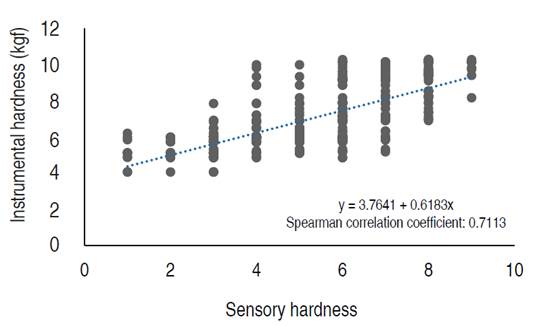
Figure 1 Relationship between instrumental and sensory hardness (hardness values obtained for 21 meat cuts evaluated using the Warner-Bratzler blade cutting force (FWB) as instrumental method and the sensory panel).
The regression equation of the measurements of Warner-Bratzler shear force (FWB) test and the values obtained in the sensory panel was created to calculate the cutting force value corresponding to the scores given by the panelists on the scale: y = 0.6103x + 3.7641; where:
y = Instrumental hardness and x = Sensory hardness.
The values obtained from the sensory panel scale were compared with the results obtained by the instrumental test (FWB) for the same meat cuts, thus, the hardness scale could be generated for the meat evaluated in this experiment.
According to the scale of hardness proposed for this study (Table 3), the meat cuts Lomo and Paletero are considered within the category of "soft" while the meat cuts Bota and Muchacho are classified within the "medium" category, although it should be mentioned that the meat cut Muchacho had similar values to the lower limit of the "hard" category (it presented a higher hardness value (FWB)) than meat cut Bota. The largest differences with the scales found in the literature (Table 4) were in the Warner-Bratzler blade shear force (FWB) values that defined the limits for each category; for example, the lower limit of the proposed scale is < 4.380 kgf with a sensory interpretation of "very soft", while in the scales used as a reference, the trait "very soft" or "soft" were assigned to values less than 3.9 kgf.
The shear force values (FWB) for the four meat cuts evaluated in this study are considered in the category of "extremely hard" according to the scale of Shackelford et al. (1995); the meat cuts Lomo and Paletero were located in the category of "hard" according to the scale of Destefanis et al. (2008) and Calkins and Sullivan (2011), while the meat cuts Bota and Muchacho were considered "very hard " according to Destefanis et al. (2008) and "hard" as the upper limit for Calkins and Sullivan (2011).
According to the classification given by those authors, the meat cut Paletero (IF) was considered one of the softest meat cuts with average values of 3.2 kgf and sensory category "soft" as in this research. The meat cut Lomo presented values that ranged between 4.07 and 4.20 kgf, which means that it belongs to the intermediate sensory category in the scales used as reference (Table 4), while was considered soft in the scale proposed in the present work.
Feeding systems
The four feeding systems evaluated were rotational grazing and strips grazing, whose diet was based on forages supplied through grazing, the stable system with a diet of grains and cut forages, and feedlot with vegetable residues. Significant differences (P=0.0007) were found between feeding systems for instrumental hardness.
The shear force values obtained for the forage-based diets, both in rotational grazing and strips (did not show significant differences between them) were the lowest in comparison with the other diets and feeding systems (Table 5). The group of stabled animals did not show significant differences with the grazing groups, which agrees with that reported by Lage et al. (2012) in the tenderness of loins from animals supplemented with concentrate at 0.8 and 1.2% of body weight. In contrast, Jiang et al. (2010) found no significant differences in shear forces and sensory perceptions of the tenderness of loins from animals in a feedlot system (finishing with alfalfa and grains), one diet with triticale and ryegrass, another one based on triticale forage and kale, and the third one with ryegrass, fescue and finished in a feedlot of alfalfa and grain; although Jiang et al. (2010) reported that significant differences were found in juiciness and flavor due to lower marbling of the loins from forage-based diets.
Likewise, it was found that the group of stabled animals had higher values of shear force (hardness) than grazing animals, in contrast to what was found by other authors who have reported that animals fed with pasture-based diets showed higher values of shear force with a Warner-Bratzler blade and presented the worst scores in tenderness given by consumers, compared to those fed with high protein and energy diets. This was attributed to the low percentage of marbling in the carcasses found in those studies (Warner et al., 2010; Sterman and De Felício, 2010).
Camacho (2008) pointed out that high protein and energy diets, typically those with a high percentage of concentrate or grains, especially in the finishing phase, lead to obtaining heavier carcasses with higher yields, due to rates of higher growth rates that allow reaching slaughter weights in a shorter time. Higher levels of marbling or intramuscular fat deposition and greater fattening of the carcass have also been found, while meats produced based on forages presented less marbling, darker colors, and higher hardness values (Vásquez et al., 2007). Batista et al. (2016) demonstrated this assertion by finding that finishing diets rich in energy increased the deposition of adipose tissue in animals of the Nellore breed and had a positive impact on the tenderness of the meat.
On the other hand, the last group evaluated in this study belonging to a feedlot system behaved statistically different from the group of grazing animals but had a statistically equal behavior to the housed group presenting higher hardness values. These results can be attributed to the content of the diets supplied and their nutritional value, since the diet was based on residues of vegetables, fruits, and tubers, with a lower energy content than that found in commercial concentrate.
Sexual condition
This factor significantly affects intramuscular fat deposition, juiciness, and palatability in meat (Vásquez et al., 2007). The results for instrumental hardness obtained through the Warner-Bratzler blade shear force (FWB) test for Lomo (Longissimus dorsi) are presented in Table 6. The loin cut was chosen because of its shear force and sensory values, also, this muscle is widely used in meat science studies to report quality traits. Significant differences were obtained between the two categories analyzed, the group of castrated animals was the one that presented the lowest hardness values (6.512 kgf) when compared with the non-castrated group, which had an average value of 7.476 kgf. This contrasts with the results found by Miguel et al. (2014) who did not find significant differences in the hardness values of late immunocastrated animals, non-castrated, and surgically castrated males.
Vásquez et al. (2007) and Latorre et al. (2017) found lower hardness values in Lomo cuts from castrated animals (4.50 to 4.75 kgf) when compared with non-castrated animals of the same age (4.9 at 5.0 kgf) but it did not show significant differences. It was also found that at the sensory level, the meat of non-castrated adult males was rated as less tender compared to the meat of castrated animals or heifers of the same age (Vásquez et al., 2007). Panjono et al. (2009) and Amatayakul et al. (2012) determined that the lower hardness values in castrated animals were attributed to their greater degree of fattening and marbling and their lower rate of maturity at slaughter, which according to the authors, was caused by the effect testosterone has on the animal by generating changes in the connective tissue through the formation of insoluble cross-links and a lower deposition of intramuscular fat, aspects that could influence the results obtained in this study.
Age at slaughter
The results obtained for instrumental hardness with the age at slaughter are presented in Table 7. Although various authors have reported statistically significant differences for the hardness values in the meat from animals of different ages, the results obtained in this work show that there were no significant differences between the age groups young (than or equal to 3 years) and old (than 3 years). Even so, it is evident that the animals within the young group presented lower hardness values (6.742 kgf) than those found in the old group (7.391 kgf).
Torregroza et al. (2016) and Vásquez et al. (2007) found that animals with a high growth rate presented a higher content of type III collagen, which is characterized by being halo-soluble and having less complexity in its structure and concluded that the meat of adult cattle is harder than young cattle, a fact that is evidenced in the results of this study. Camacho (2008) reported that in addition to the connective tissue content, the increase in the diameter of the muscle fibers given after 30 months of age generates greater resistance to cutting, especially in grazing animals such as those in this study. In this way, the higher hardness values can be explained in animals whose age range is greater than 3 years.
Biotype
The results obtained for hardness according to the animal biotype are presented in Table 8, where the presence of statistical differences was found (P=0.0053). The hardness values found for the Bos indicus animals (average of 8.265 gf) were statistically different from the other groups of animals that obtained lower values, which agrees with that reported by Hernández (2008) who stated that the meat of animals Cebu type presents weaknesses in some palatability characteristics such as hardness. This can be attributed to the lower post-mortem proteolysis resulting from the high activity of Calpastatin on Calpains that hydrolyze the contiguous bonds to cysteine (especially CAPN-1), playing a very important role in the degradation of post-mortem muscle fibers, and the maturation process (Peluffo and Monteiro, 2002; Pinilla, 2014; Desgarennes et al., 2017; Wright et al., 2018). It has also been reported in the literature that the degree of crossbreeding of animals generates differences in the tenderness of the meat, specifying that 25% Bos indicus breed in the animal already generates variation in the tenderness of the cuts; that is why meats from animals with 50% Brahman breed are less tender than meats from animals with 25% Brahman breed; which makes sense when evaluating Calpastatin increasing activity and the decreasing in post-mortem proteolysis (Camacho, 2008; Montoya, 2014; Wright et al., 2018).
The lowest hardness value in this experiment corresponded to the biotype cross-breeding with 6.284 kgf made up of individuals from the Brahman x Normande, Charolais x Brahman, Simbrah and Brangus cross-breeding. The Bos taurus biotype composed mostly of animals of the Normande breed and their crosses with meat breeds presented values of 7.093 kgf.
The type of cross-breeding also affects the level of tenderness in the meat cuts. Hernández (2008) found that there was a lower age at slaughter in the cross-breeding of Sanmartinero×Cebu and Simmental×Cebu compared to the Cebu pure breeding and cross-breeding with Romosinuano, breeds with rapid growth allow the animals to be slaughtered at lower ages, obtaining better tenderness values (lower FWB). In this study, better tenderness values were obtained in the meat cuts from cross-biotype breeding concerning Bos taurus and Bos indicus. It is important to note that the animals of the Bos taurus group in this work were mostly Normande specimens and cross-breeding with Normande, breeds that are not specialized in meat production and do not show rapid growth, that is the reason why values were attributed to superior hardness to this biotype when compared with the cross-breeding group.
Vásquez et al. (2006; 2007) reported shear force values greater than 5 kgf in loins from Brahman and Brangus breeds animals when compared with pure Romosinuano, Romosinuano×Cebu and Cebu×taurus mixtures, obtaining values of 4.23, 4.78 and 4.26 kgf, respectively; this trend was also presented in the results obtained for this work, where the values of shear force obtained for cross-bred animals were found to be smaller than pure breeds, and the highest values were found in Bos indicus biotypes. Results for hardness when comparing biotypes agree with values reported by Lage et al. (2012) who compared the meat cuts of Nellore breed animals with Angus and Simmental×Nellore, always obtaining the highest hardness values in Nellore.
CONCLUSIONS
The instrumental and sensory hardness of the meat cuts are largely determined by the handling given to the animals within the production systems. Likewise, the type of muscle used has a direct impact on the final hardness perceived by the consumer due to the nature of the muscle fibers, their level of development and their anatomical location. In this way, a potential use of the Paletero meat cut was found due to its similarity to the Lomo. The high correlation was obtained between the instrumental method and the sensory method allowed the creation of a hardness scale for the classification of meat cuts and represented the first approach made for meat cuts in the region of Cundinamarca, Colombia. Its application is suggested in areas with similar characteristics to those found in this project.















